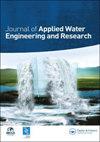Application of cascade feed forward neural network to predict coagulant dose
IF 1.6
Q4 WATER RESOURCES
Journal of Applied Water Engineering and Research
Pub Date : 2021-05-31
DOI:10.1080/23249676.2021.1927210
引用次数: 10
Abstract
Inlet water quality fluctuations affect mainly coagulant dose, and outlet water quality of the water treatment plant (WTP). Many complex physical and chemical processes are involved in WTP and water distribution networks (WDN). These technologies show non-linear behavior, which is challenging to be described by linear mathematical models. Thus, there is a need to develop prediction models for coagulation dose. The present study involves the application of cascade feed-forward neural networks (CFFNN) to predict coagulant dose. CFFNN Model was developed by using the Levenberg-Marquardt Training Algorithm and Bayesian Regularization Training Algorithm to predict coagulant dose. During the development of these models, hidden nodes are varied from 15 to 60, and R is found between 0.914 and 0.947. The best results were obtained by the CFFNN model using the Bayesian Regularization Training Algorithm (CFNNCD2) with hidden node 40, where R = 0.945 for training and 0.947 for testing.级联前馈神经网络在混凝剂剂量预测中的应用
进水水质波动主要影响水处理厂(WTP)的混凝剂剂量和出水水质。水处理厂和配水网络(WDN)涉及许多复杂的物理和化学过程。这些技术表现出非线性行为,用线性数学模型来描述这一行为具有挑战性。因此,需要开发凝血剂量的预测模型。本研究涉及级联前馈神经网络(CFFNN)在预测混凝剂剂量方面的应用。利用Levenberg-Marquardt训练算法和贝叶斯正则化训练算法建立了CFFNN模型来预测混凝剂剂量。在这些模型的开发过程中,隐藏节点从15到60不等,R在0.914到0.947之间。使用具有隐藏节点40的贝叶斯正则化训练算法(CFNNCD2)的CFFNN模型获得了最佳结果,其中R = 0.945用于培训,0.947用于测试。
本文章由计算机程序翻译,如有差异,请以英文原文为准。
求助全文
约1分钟内获得全文
求助全文
来源期刊

Journal of Applied Water Engineering and Research
WATER RESOURCES-
CiteScore
2.90
自引率
16.70%
发文量
31
期刊介绍:
JAWER’s paradigm-changing (online only) articles provide directly applicable solutions to water engineering problems within the whole hydrosphere (rivers, lakes groundwater, estuaries, coastal and marine waters) covering areas such as: integrated water resources management and catchment hydraulics hydraulic machinery and structures hydraulics applied to water supply, treatment and drainage systems (including outfalls) water quality, security and governance in an engineering context environmental monitoring maritime hydraulics ecohydraulics flood risk modelling and management water related hazards desalination and re-use.
 求助内容:
求助内容: 应助结果提醒方式:
应助结果提醒方式:


